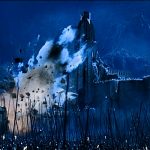
The Lord of the Rings: The Two Towers – 2002
The second installment of the Lord of the rings trilogy was just as impressive as the first one. It had the same cast of wonderful actors: Ian McKellan, Elijah Woods, Sean Astin, Viggo Mortensen, John Rhys-Davies, Orlando Bloom, Billy Boyd, Dominic Monaghan, Christopher Lee, Liv Tyler, and Hugo Weaving. The same high standard was maintained when it came to sets and costumes. The same spectacular cinematography was just as captivating as before. So what made this installment different? What was it about the two towers that made it special?
For me, there were two things that made it particularly impressive. The first was a new member of the cast, Andy Serkis, playing the complex and fascinating role of Gollum. The second was the over-the-top battle sequences, the likes of which had never been seen before. Each was a phenomenal combination of both live actors and CGI imagery. So, as much as the live actors have to be commended, the digital graphics artist have to be given just as much credit.
Serkis, of course, wasn’t really a new member of the cast. He had been in the first movie, but his role had been so small that it was negligible. Here, in the two towers the character was really given life, and became an integral part of the plot. Serkis performed his part dressed in a motion capture suit, and he was rotoscoped. His realistic facial expressions were all the product of manual animation. This is saying something, because most CGI representations have a very stilted way of moving and stiff facial expressions. The result of this awesome technology, was one of the most incredibly realistic CGI characters I’ve ever seen.
And it wasn’t just his physical representation that was impressive. It was the way his character was written, something that goes back to the source material, written by J.R.R. Tolkien. There was both light and dark in him, forces that were constantly battling one another for control of the individual. The dark side, the evil, deceitful, and murderous side, was Gollum. The other side, the timid and subservient side, was. Smeagol. They both lived in the same body, the same mind. Serkis was incredible as he portrayed each side, especially during the parts where he had to argue with himself. The actor did a remarkably good job.
And then there were the battle sequences, or more specifically, the battle for Helms deep. Yes, many of the combatants, humans, elves, and orcs alike, were computer generated, especially for the wide shots. These were mixed in seamlessly with the live actors. In this way, Director Peter Jackson was able to show us the true enormity of the battle’s epic scale. And the CGI artists really had their work cut out for them. The complexity of the battle and the realism that it portrayed, must’ve been a staggering task that was set before them, but they really stepped up to the plate and showed us something that we’ve never seen before.
Now, there were a few other newcomers to the cast you really did a fine job of holding the standard of acting set by the main cast of The Fellow ship of the Ring. Bernard Hill played Theoden, King of the country of Rohan. His niece, Eowin, played by Miranda Otto, and his nephew, Eomer, played by Karl Urban, were fantastic. In the great city of Gondor, we meet dead Boromir’s father, Denethor, played by John Noble, and his brother, Faramir, played by David Wenham. On the evil Sauron’s side, we met Grima Wormtonge, played by Brad Douriff.
As you can tell by the ever-growing list of characters, the story gets very complex. But it’s fairly easy to follow, as they each have a very unique and distinct look, making it easy to tell them and their stories apart. And lest I forget, another important character in the story, is Treebeard. He is another CGI character, and his voice by the same actor who plays Gimli, the dwarf, John Rhyes Davies. But I’ll be honest, I was less impressed with the CGI on him, and his fellow Ents. Their movement often looks stiff and a mechanical. But I can forgive this because, after all, they were trees, with limbs that were not supposed to bend much.
And while I’m on the subject of things that I didn’t like about the film, which were few, I have to mention how the character of Gimli, always one of my favorites, had been turned into little more than comic relief for the film. This was unnecessary. While he still had his moments of coolness, he was also given a string of one liner jokes that didn’t really need to be there. It just made his character looks silly, while not adding much to the plot.
Another thing that fans of the films didn’t like was that there were more departures from the original books in the Two Towers than there were in The Fellowship of the Ring. Theoden was not possessed by Saruman. Aragorn never fell off a cliff to be presumed dead. Elves did not come to Theoden’s aid at Helm’s Deep. And Frodo and Sam never went to Osgiliath. Jackson’s script actually gave a quick nod to that one when Sam exclaims, “By all rights, we shouldn’t even be here.” But the changes were minor enough that it didn’t detract from the story telling much. It was still an incredible and worthy episode of the saga, as a whole.








